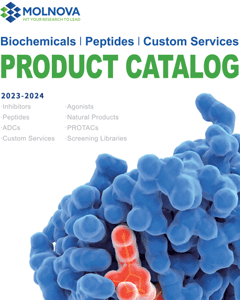
Metoclopramide hydrochloride hydrate
CAS No. 54143-57-6
Metoclopramide hydrochloride hydrate( AHR-3070-C, Maxolon, Metoclopramide HCl, Metoclopramide monohydrochloride monohydrate, Metozolv, Reglan )
Catalog No. M14937 CAS No. 54143-57-6
A potent dopamine D2 receptor antagonist with Ki of 28 nM; also is a mixed 5-HT3 receptor antagonist/5-HT4 receptor agonist.
Purity : >98% (HPLC)
 COA
COA
 Datasheet
Datasheet
 HNMR
HNMR
 HPLC
HPLC
 MSDS
MSDS
 Handing Instructions
Handing Instructions
| Size | Price / USD | Stock | Quantity |
| 100MG | 67 | Get Quote |


|
| 200MG | 88 | Get Quote |


|
| 500MG | 133 | Get Quote |


|
| 1G | Get Quote | Get Quote |


|
Biological Information
-
Product NameMetoclopramide hydrochloride hydrate
-
NoteResearch use only, not for human use.
-
Brief DescriptionA potent dopamine D2 receptor antagonist with Ki of 28 nM; also is a mixed 5-HT3 receptor antagonist/5-HT4 receptor agonist.
-
DescriptionA potent dopamine D2 receptor antagonist with Ki of 28 nM; also is a mixed 5-HT3 receptor antagonist/5-HT4 receptor agonist; commonly used to treat nausea and vomiting caused by chemotherapy.Chemotherapeutic Agents Phase 2 Discontinued(In Vitro):Metoclopramide (0.01-10 μM) hydrochloride hydrate stimulates aldosterone release in isolated perfused rat zona glomerulosa cells.Metoclopramide hydrochloride hydrate results in prokinesis by four mechanisms: inhibition of presynaptic D2 receptors and stimulation of presynaptic excitatory 5-HT4 receptors, thereby allowing acetylcholine (ACh) release from intrinsic cholinergic motor neurons; inhibition of D2 postsynaptic receptors; and antagonism of the presynaptic inhibition of muscarinic receptors, leading to further augmentation of ACh release.(In Vivo):Metoclopramide (6.7 μg/g; s.c. daily for 50 days) hydrochloride hydrate significantly increases the number and the volume of lactotroph cells of the pituitary gland during all phases of the estrous cycle.Metoclopramide (5-40 mg/kg; i.p.) hydrochloride hydrate induces catalepsy and antagonizes Apomorphine induced cage climbing behaviour in mice.Metoclopramide (1.25-2.5 mg/kg; i.p.) hydrochloride hydrate induces stereotyped cage climbing behaviour in mice.
-
In VitroMetoclopramide (0.01-10 μM) hydrochloride hydrate stimulates aldosterone release in isolated perfused rat zona glomerulosa cells.Metoclopramide hydrochloride hydrate results in prokinesis by four mechanisms: inhibition of presynaptic D2 receptors and stimulation of presynaptic excitatory 5-HT4 receptors, thereby allowing acetylcholine (ACh) release from intrinsic cholinergic motor neurons; inhibition of D2 postsynaptic receptors; and antagonism of the presynaptic inhibition of muscarinic receptors, leading to further augmentation of ACh release.
-
In VivoMetoclopramide (6.7 μg/g; s.c. daily for 50 days) hydrochloride hydrate significantly increases the number and the volume of lactotroph cells of the pituitary gland during all phases of the estrous cycle.Metoclopramide (5-40 mg/kg; i.p.) hydrochloride hydrate induces catalepsy and antagonizes Apomorphine induced cage climbing behaviour in mice.Metoclopramide (1.25-2.5 mg/kg; i.p.) hydrochloride hydrate induces stereotyped cage climbing behaviour in mice. Animal Model:Adult, virgin female mice of the Swiss EPM-1 strainDosage:6.7 μg/g Administration:S.c. daily for 50 days Result:Increased the number but also stimulated the metabolic activity of lactotrophs.
-
SynonymsAHR-3070-C, Maxolon, Metoclopramide HCl, Metoclopramide monohydrochloride monohydrate, Metozolv, Reglan
-
PathwayGPCR/G Protein
-
TargetDopamine Receptor
-
RecptorDopamine Receptor
-
Research AreaCancer
-
IndicationChemotherapeutic
Chemical Information
-
CAS Number54143-57-6
-
Formula Weight354.2726
-
Molecular FormulaC14H25Cl2N3O3
-
Purity>98% (HPLC)
-
Solubility10 mM in DMSO
-
SMILESO.Cl.CCN(CC)CCNC(=O)c1cc(Cl)c(N)cc1OC
-
Chemical NameBenzamide, 4-amino-5-chloro-N-[2-(diethylamino)ethyl]-2-methoxy-, hydrochloride, hydrate (1:1:1)
Shipping & Storage Information
-
Storage(-20℃)
-
ShippingWith Ice Pack
-
Stability≥ 2 years
Reference
1. Matsui A, et al. J Pharmacol Exp Ther. 1998 Nov;287(2):725-32.
2. Tonini M, et al. Pharmacol Res. 1995 May;31(5):257-60.
3. Bateman DN, et al. Br J Clin Pharmacol. 1978 Nov;6(5):401-7.
molnova catalog



related products
-
5-HT6/7 antagonist 1
5-HT6/7 antagonist 1 is a dual 5-HT6/7/2A and D2 receptor antagonist used in the study of dementia and Alzheimer's disease.
-
Amantadine hydrochlo...
Amantadine Hydrochloride is an antiviral and an antiparkinsonian drug.
-
3-CPMT
3-CPMT is a dopamine uptake inhibitor and a potent long-acting antihistaminic agent.



 Cart
Cart
 sales@molnova.com
sales@molnova.com


